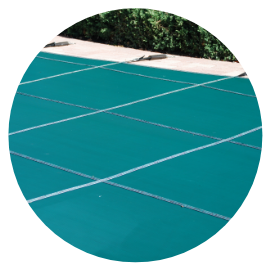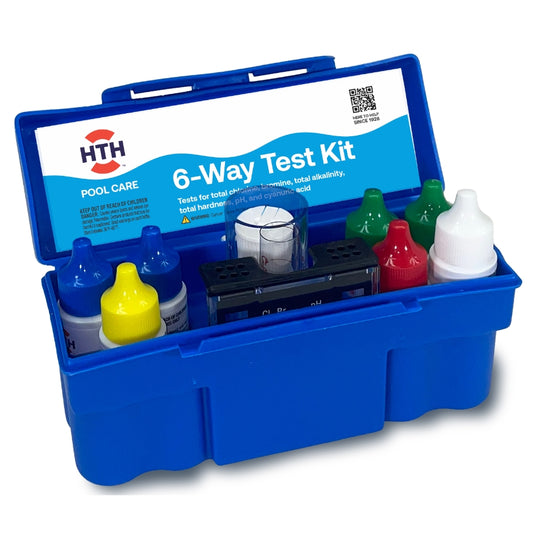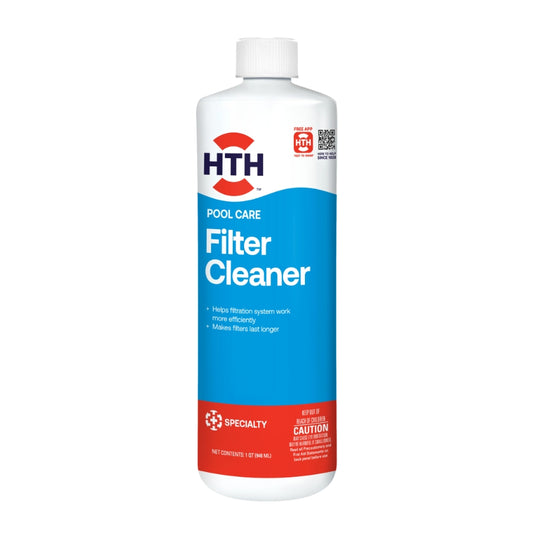How to: Close an above ground pool

Need more help?
Call us
Prefer to call us?
We've got someone standing by daily from 9 a.m. – 7 p.m. ET, Monday – Friday
(866)-HTH-POOL- Category:
- Above Ground Pools •
- Pool •
- Pool Closing •
- Pool Maintenance •
If your pool season is winding down, remember that properly closing your above ground pool is essential to maintaining it. By following the proper steps, you can help protect the pool surfaces and equipment during the winter, saving yourself time and money when you open the pool back up in the spring. Whether you start once the kids have gone back to school or wait a little longer, the choice is up to you. Just be sure you leave time to treat the water, and inspect and prepare the equipment before temperatures dip below freezing. There are three basic stages in closing an above ground pool:
1. Treating the pool water If your pool season is ending, you should still continue to treat your water before freezing temperatures arrive. This will help protect the pool against corrosion and scale buildup. Test your pool water using an HTH™ Pool Care 6-Way Test Kit. The test readings will show you the appropriate level of winterizing products to add to the water. To maintain a healthy balance, periodically check the sanitizer level and pH, and, depending on the results, you may need to adjust the chemical levels as necessary to correct any imbalance before closing the pool. Your pool water should be maintained within the following ranges: 7.2 to 7.6 pH range 60 to 120 ppm alkalinity range 200 ppm or above calcium hardness range
2. Closing down Filter treatment: All filters should be chemically cleaned as part of the closing procedure. Sand and DE filters require operation of the pump as part of the cleaning and backwashing procedure. Follow the directions on the HTH™ Pool Care Filter Cleaner label to clean the filter. Then follow the filter manufacturer’s directions as well as the additional instructions below for each filter type to drain and prepare the filter for closing. Once the sand filter is cleaned and backwashed, turn off the pump, remove the filter drain plug and allow all the water to drain from the filter. If the pump and filter are connected with flexible hoses we recommend you disconnect the hoses, drain and store them out of the weather. For a DE filter, follow the manufacturer’s directions for backwashing off the media. Then remove the grids or fingers, and properly clean, rinse, dry and store them according to the manufacturer’s directions. Remove all drain plugs or open all valves as instructed to allow water to drain from the housing. If you have a cartridge filter, once the circulation system is shut down remove the cartridge, chemically clean it and inspect it for tears or broken bands that might need replacement. Drain the housing as appropriate. It’s also important to ensure not only that the cartridge is completely dry, but that it’s stored in a dry location. Cartridge filters need to dry. This greatly extends the life of the cartridge and improves its effectiveness. For all three types of filters be sure to store all drain plugs, baskets and other small items in one place so that they don't get lost. As with in-ground pools, lower the water level below the skimmer and any inlets. If the inlet is merely the return line set over the wall, then simply remove it. But closing doesn't end there: Keep in mind that taking proper care of the equipment will help extend the overall life of the pool. Skimmer treatment: It’s important to prepare the skimmer in these types of pools because if they freeze, they will be irreparably damaged. The process for doing so may vary depending on your pool type: - Remove the return hose from the skimmer. - If your pool has a through-the-wall skimmer, drain it and detach the suction line in the bottom. - In some pools, the skimmer is located inside the pool, in which case you can simply remove it. - Next, drain the pump housing, hair and lint strainer basket and filter as appropriate. - We recommend that all equipment be either stored or covered to keep it dry and protect it from extreme weather.
3. Covering your pool Finally, you may wish to cover the pool to protect against debris entering the pool while it sits unused. Make sure the cover you use is resistant to water, pool chemicals and the weather in your region. Follow the manufacturer’s instructions, which typically include the following three steps to keep the cover secure throughout the winter: Tie down. Aboveground covers are available with grommet edges that allow for a secure tie-down. Be sure to tightly anchor the edges of the cover to prevent wind from getting under it. This will save you cleanup time when you reopen. Secure. Next, secure the cover to prevent the wind from pulling it off the pool. Most pool owners place an inflated vinyl pillow under the cover that creates a loose tent and fill the sag around the pillow with water. Inspect. Lastly, inspect any ladders, automatic cleaners or ancillary equipment in case anything needs repair and store it all in a dry area where it will be protected from freezing temperatures. Following the necessary steps in closing an above ground pool takes a bit of work, but doing so can help keep the pool components running efficiently so all you have to do is enjoy your swim next spring.
As always, we’re here to help. If you have questions, contact our help line at 1-866-HTH-POOL or talk to our experts with our live chat!
Caution
Please read the following important reminders before adding pool chemicals to water:
• NEVER mix products together or dissolve before use.
• ONLY enter pool when FAC levels are below 4 ppm to prevent risk of bodily harm.





